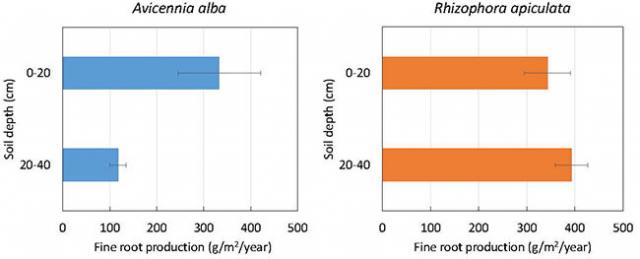Home > Research > Research Results > Research Results 2020 > The production rate of fine roots in mangrove forests differs significantly by tree species
Update:November 9, 2020
Main content starts here.
The production rate of fine roots in mangrove forests differs significantly by tree species
| Article title |
Biomass and Production Rates of Fine Roots in Two Mangrove Stands in Southern Thailand |
|---|---|
| Author (affiliation) |
Kyotaro Noguchi (a), Sasitorn Poungparn (b), Suthathip Umnouysin (b,c), Pipat Patanaponpaiboon (b), Decha Duangnamol (d), Reiji Yoneda (e), Hajime Utsugi (f), Tamotsu Sato (g), Ryuichi Tabuchi (h) (a) Tohoku Research Center, FFPRI, Morioka, Iwate, Japan. (b) Chulalongkorn University, Bangkok, Thailand. (c) Silpakorn University, Nakhon Pathom, Thailand. (d) Kasetsart University, Ranong, Thailand. (e) Shikoku Research Center, FFPRI, Kochi, Japan. (f) Principal Research Director, FFPRI, Tsukuba, Ibaraki, Japan. (g) Department of Forest Vegetation, FFPRI, Tsukuba, Ibaraki, Japan. (h) Center for Forest Restoration and Radioecology, FFPRI, Tsukuba, Ibaraki, Japan. |
| Publication Journal |
JARQ (Japan Agricultural Research Quarterly), 54(4), October 2020 URL:https://www.jircas.go.jp/en/publication/jarq/2019j04( External link ) |
| Content introduction |
In addition to being used as resources for wood and fuel production, mangrove forests have been attracting attention in recent years for their ecological functions, such as their role as carbon sinks. Because carbon, which is fixed by photosynthesis, is used not only for the growth of above-ground parts of trees, but also for the growth of roots, it is necessary to know the production rates of both above-ground and below-ground parts in order to evaluate the carbon sink functions of forests. However, studying roots that are hidden beneath the ground is often plagued with problems, and there is a lack of information about roots in mangrove forests. Therefore, in this study, two types of typical mangrove stands in Southern Thailand were studied: an Avicennia alba stand (which has pneumatophores (roots like bamboo shoots)) and a Rhizophora apiculata stand (which has prop roots) (photos). The production rate of fine roots (having a diameter of less than 2mm) was studied from the ground surface down to a depth of 40cm. As a result, it was found that the production rate of fine roots in one year was 450 g/m2 (4.5 tonnes/hectare) in the Avicennia alba stand, and 740 g/m2 (7.4 tonnes/hectare) in the Rhizophora apiculata stand, and we could see that these figures were as large as 60% and 95%, respectively, of leaf litter (≒ amount of leaves produced) of the two types. In addition, differences could be seen in the production of fine roots. For example, fine root production in the Avicennia alba stand flourished in the surface soil layer (depths of 0-20cm), while in the Rhizophora apiculata stand, fine root production was about the same in lower depths (20-40cm) as it was in the surface soil layer (Fig. 1). From these results, we acquired new knowledge that suggests that production rates of roots, their distribution in the soil and the balance between the above- and below-ground productivity in mangrove forests differs greatly depending on the mangrove species and characteristics of their habitats. In addition, the data on fine root production that was obtained from this study will provide useful knowledge for evaluating the rate at which carbon is stored in these mangrove stands.
Figure 1. Fine root production at depths of 0-40cm in the Avicennia alba stand (left) and the Rhizophora apiculata stand (right). |
Copyright © Forest Research and Management Organization. All rights reserved.


